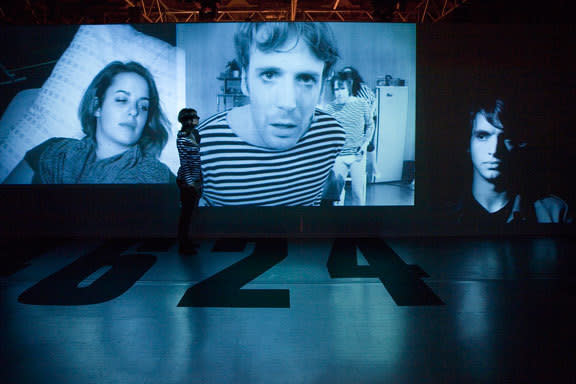TBA Day 9: Gob Squad's Kitchen Review

Before the show begins, performers invite the audience to tour the backstage “movie studio,” which is set up like Warhol’s Factory studios: there’s the bed for Sleep, the kitchen for Kitchen, and a sofa for Screen Shots. From our seats, though, all we see is a large screen with the three sets projected through live video feeds. In the kitchen set, Sean Patten walks up to the camera, his face growing large on our screen, and begins: “My name is Sean, and I’m playing Sean in Andy Warhol’s Kitchen. It was made in 1965, and that’s where we’re going.” And with that, the two primary tensions of the show—between authenticity and performing, and between now and then—are unleashed like two starry-eyed Midwestern kids at one of the Factory’s legendary drug-fueled art parties.
The first half of the show is rambling and hilarious, as the actors, all master improvisers (each night they change roles), attempt to recreate Warhol’s films but instead find themselves in existential, chronological, and artistic conundrums. What are they to do for the awkward opening of Kitchen if they can’t smoke? Must they drink their Nescafe black, or can they invent the cappuccino? Sean calls Simon Will’s flamboyance cliché, to which Simon responds, “In the future, I will be a cliché, but right now, before Stonewall, I am courageous."
Their goal, Sean announces with excitement at one point, is to capture the essence of the 60s, when everything was new and exciting, no one knew what they were doing, and sexual liberation, civil rights, and gay rights were just beginning. In the process, they manage to pay homage to Warhol’s time and films (you’ll also see Eat, Kiss, and Blow Job), while devilishly skewering them at the same time. Ten minutes into the show, Sharon Smith (looking like a pixie Edie Sedgwick drop-in), who’s been lying in the bed for Sleep (which was a five-hour endurance film of poet John Giorno doing the title activity), walks into the kitchen and says, “I can’t sleep. It’s the concept. I don’t get it. Why would someone make a film about someone asleep, and then people would come to watch it?”
Sean takes over for a bit, playing Sharon in Sleep, but also fails. “I’m an even worse you than you,” he tells Sharon, before sending us down the rabbit hole with the question: “What’s your ideal Sharon?” Sharon describes a younger but still wise version, and then goes out into the audiences and picks someone, who she puts in the bed with instructions for the scene. Soon after, Sean storms off the kitchen set during the party scene, saying they’re getting it all wrong, and sends in an audience member as himself, feeding her lines through a headset while he sits in the audience.
We’ve seen audience participation in Big Art Group’s The People—Portland, where locals were given one rehearsal and cue cards, and in Keith Hennessy/Circo Zero’s Turbulence, where folks are invited onstage for all sorts of potentially risky shenanigans, but we’ve not seen audience participation this ingenious. We get to watch the eyes of the audience actors dart back and forth close up on the big screen as they try to process the increasingly outlandish lines and directions they are receiving and now performing before a live audience. While the three main audience members rose to their roles with incredible charisma and humor, they also functioned as stand ins for the rest of us, letting us share in their nervousness and ultimately creating one of the most electrically awkward moments I've ever experienced in a performance, which I'll let you squirm through on your own.
In the end, Gob Squad creates the very thing it set out to create, but in a way you would never have imagined, and with a tenderness that doesn’t seem possible given the parody.
In the context of the rest of the festival, Kitchen feels like the culmination of a series of growing themes. Beginning with The People—Portland, continuing through Miguel Gutierrez’s and Turbulence (and to a lesser extend Perforations), we’ve seen theater deconstructed. Not only have the performances been about the act of creating a performance, but they’ve used audience participation, live video, and other lo-fi multimedia to break down the walls that tend to encase the “artist” and the “art,” blurring the boundaries between audience and performer, life and art. After all, haven’t social media and YouTube proven Warhol prescient by making it possible for anyone to be a star? But none of the previous performances quite hit its mark.
Gob Squad hits the mark. See this show.
